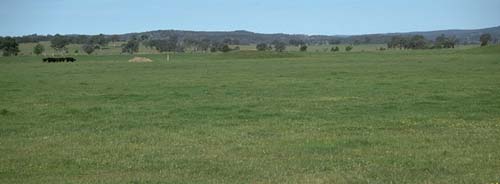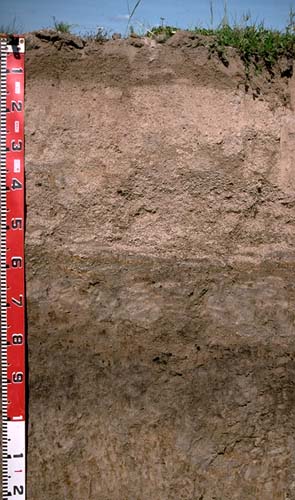NE14
| Group: Springhurst-Byawatha Hills Landcare Group | Australian Soil Classification: Bleached, Eutrophic, Grey KANDOSOL (sandy / loamy) |
| Northcote Factual Key: | Great Soil Group: no suitable group |
| General Landscape Description: Old alluvial plain with prior stream activity. This site occurs on a prior stream channel. Original vegetation included Grey Box (Eucalyptus microcarpa) and Blakely's Red Gum (E. blakelyi). | |
Site Description:
 NE14 landscape |
Soil Profile Morphology:
Surface Soil
A1 | 0-10 cm | Dark brown (10YR3/3); loamy sand; firm consistence moist; quartz gravel (4mm); pH 6.3; abrupt change to: |  NE14 profile |
A21 | 10-35 cm | Light yellowish brown (10YR6/4) conspicuously bleached (10YR8/3d); coarse sand; structureless; weak consistence dry; pH 6.3; clear change to: | |
A22 | 35-55 cm | Coarse sand; very weak consistence dry; contains many (25%) quartz gravel fragments (4mm average size) and ferromanganiferrous nodules (up to 20mm size); pH 6.8; sharp change to: | |
| Subsoil | |||
B2 | 55-65 cm | Light grey (10YR7/2) with yellowish brown (10YR6/8) mottles; sandy loam; cemented in patches; very firm consistence moist; contains a few (2%) ferruginous nodules (< 8mm size); pH 6.5; sharp change to: | |
B3 | 65-75 cm | Brown (10YR5/3); silty loam; weakly structured; firm consistence dry; pH 6.1; abrupt change to: | |
2A1 | 75-80 cm | Pale brown (10YR6/3); clayey sand; weak consistence moist; contains a few (10%) quartz gravel (4mm average size); clear change to: | |
2B21 | 80-85 cm | Pale brown (10YR6/3); light sandy clay loam; weak consistence moist; clear change to: | |
2B22 | 85-100 cm | Pale brown (10YR6/3); silty clay loam; weakly structured; weak consistence moist; contains dark stains (5YR3/2); clear change to: | |
2B23 | 100 cm+ | Pale brown (10YR6/3) with yellowish brown (10YR5/8) mottles; silty clay; weakly structured; firm consistence moist; pH 6.1. | |
Key Profile Features:
- Buried soil horizons due to varying stream channel deposition.
- High coarse sand contents throughout most of the profile.
Soil Profile Characteristics:
Horizon | pH | Salinity Rating | ||
Surface (A1 horizon) | slightly acid | very low | non sodic | none |
Subsoil (B21 horizon) | slightly acid | very low | non sodic | slight |
Deeper subsoil (at 1 m) | slightly acid | very low | sodic | none1 |

Horizon | Horizon Depth (cm) | pH (water) | pH (CaCl2) | EC 1:5 | Exchangeable Cations | |||
Ca | Mg | K | Na | |||||
meq/100g | ||||||||
A1 | 0-10 | 6.3 | 5.2 | 0.05 | 1.9 | 0.7 | 0.7 | <0.1 |
A21 | 10-35 | 6.3 | 5 | <0.05 | 0.7 | 0.3 | 0.4 | <0.1 |
A22 | 35-55 | 6.8 | 5.8 | <0.05 | 1.0 | 0.4 | 0.3 | <0.1 |
B2 | 55-65 | 6.5 | 5.4 | <0.05 | 2.8 | 2.1 | 0.7 | 0.1 |
B3 | 65-75 | 6.1 | 5.2 | 0.07 | 2.1 | 2.0 | 0.4 | 0.1 |
2B23 | 100+ | 6.1 | 5 | 0.11 | 2.0 | 3.7 | 0.2 | 0.7 |
Horizon | Horizon Depth (cm) | Field Capacity pF 2.5 | Wilting Point pF 4.2 | Coarse Sand (0.2-2.0 mm) | Fine Sand (0.02-0.2 mm) | Silt (0.002-0.02 mm) | Clay (<0.002 mm) |
A1 | 0-10 | 11 | 3 | 66 | 21 | 7 | 5 |
A21 | 10-35 | 8.6 | 2.1 | 53 | 33 | 10 | 4 |
A22 | 35-55 | 6.4 | 1.7 | ||||
B2 | 55-65 | 15.3 | 6.1 | 59 | 16 | 6 | 17 |
B3 | 65-75 | 25.7 | 6 | 4 | 46 | 30 | 13 |
2B23 | 100+ |
Management Considerations:
Whole Profile
- Plant available water capacity (PAWC) is considered to be very low (estimated at approximately 24 mm). This is based on available laboratory data and assumes an effective rooting depth of 55cm. Rooting depth will be restricted by the weakly cemented horizon at 55-65cm depth.
Surface (A) Horizons
- The surface horizon has a very high coarse sand content (66%) and contains quartz gravel. As a consequence infiltration of water will be high, but water storage capacity is very low. These soils are therefore prone to becoming ‘droughty’ throughout most of the year. The low wilting point value, however, indicates that plants will be able to utilise light rains when the soil is relatively dry.
- The surface soil has a very low inherent fertility (based on the sum of the exchangeable basic cations). The low cation exchange capacity means that nutrients from fertiliser application will be more easily leached out than for heavier textured soils.
- Based on the analytical results for a bulked paddock sample taken around this site, the phosphorus level is low for a lightly stocked paddock. The State Chemistry Laboratory (SCL) recommends that this part of the paddock be topdressed in autumn with 11-12 kg/hectare of actual phosphorus. The same topdressing should be applied in the following year.
- Sulphur levels are low to marginal for the bulked paddock sample taken around this site. SCL recommends that a fertiliser with a reasonable sulphur content (at least 6%) should be used. On light textured soils like this site, SCL suggests applying at least some of the sulphur in the elemental form (rather than the sulphate form) as it is less easily leached. However, elemental sulphur should be used with caution as it is an acidifying fertiliser.
Subsoil (B) Horizons
- The 55-65cm horizon is weakly cemented and is likely to restrict root movement. Most roots observable in the soil pit occurred above 55cm depth.
- The subsoil has a low inherent nutrient status (based on the sum of the exchangeable basic cations).


